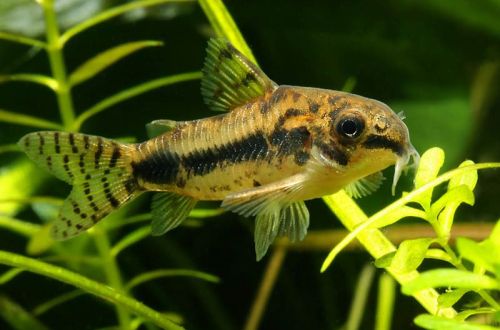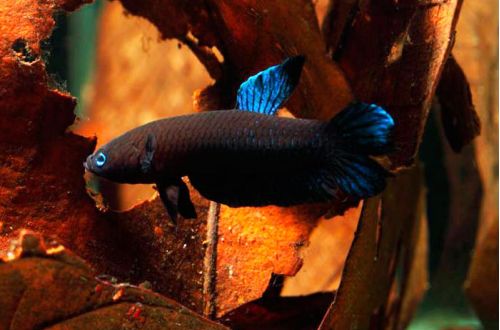
kissing gourami
The kissing gourami, scientific name Helostoma temminkii, belongs to the Helostomatidae family. One of the most amazing aquarium fish, unusual behavior, not typical of other species, has attracted attention for many decades. This species became popular as soon as it was commercially bred in Florida in the distant 50s, although it has been known to science since the 19th century.
Most aquarists who become interested in Gourami end up with the Kissing Gourami. It is often possible to observe how fish connect with each other, pressing their lips together, and swim in this position for a long time. From the outside it really looks like they are kissing. Researchers consider such an action to be an element of maintaining the internal hierarchy through such tactile contacts.
Habitat
For the first time, the fish received a scientific description in 1829, during the study of the fauna of Southeast Asia by the French explorer Georges Cuvier. Widespread in the territory of modern Thailand and Indonesia, also found in Sumatra, Borneo, Java, Cambodia, etc. In nature, Kissing Gourami is found in lakes and rivers, as well as artificial channels, ponds and swamps. Inhabits shallow, slow moving waters with lots of vegetation. Omnivorous algae, various plants, zooplankton, aquatic insects near the surface of the water.
Description
The fish is medium in size, in the aquarium it reaches 15 cm, the body is flat, laterally compressed. The fins are large relative to the body, rounded in shape with a low landing. A distinctive feature of this species is the structure of the mouth, the lips are large, fleshy with small teeth on the inner surface, with the help of which the fish can scrape algae from stones and snags. Like other representatives of the labyrinths, Gurami has a special respiratory organ that allows it to absorb atmospheric oxygen by swallowing air through the mouth.
In nature, there are two color varieties – grayish-green and pink. The grayish-green form comes from the waters of Thailand, its body is painted in gray tones, in some individuals it acquires a greenish tint. There are distinct dark brown stripes running from tail to head and continuing on the fins.
The pink form is the most popular among aquarists. The body color is orange-pink with transparent or translucent pink fins. On its basis, the type of Pink Kissing Gourami is artificially derived, which is somewhat smaller than its predecessor.
Food
At home, they accept any food intended for aquarium fish, these are both dry industrial food (granules, flakes), and live or freeze-dried meat products (bloodworm, daphnia, tubifex, etc.). When choosing food, you should give preference to products designed specifically for Gourami, they already contain all the necessary elements and vitamins. Feed once or twice a day in an amount that will be eaten in 3-4 minutes.
Maintenance and care
There is a widespread belief that labyrinth fish successfully live in oxygen-depleted water. They can survive in such conditions for some time, which gives them a competitive advantage in the wild, but in a closed system aquarium, the lack of oxygen leads to problems with the decomposition of organic residues and an increase in the concentration of toxins that poison all living things.
An effective filtration and aeration system is essential in an aquarium, but the operating equipment should not create strong water flows, since the fish prefer slow current or stagnant water, otherwise constant stress cannot be avoided. Other important appliances are the heater and the lighting system. The lid of the aquarium is also important, a humid environment with an elevated temperature is formed under it, which minimizes the likelihood of damage to the labyrinth organ of the fish during breathing with atmospheric air due to the temperature contrast.
The best colors will be shown by the fish against a dark substrate of fine gravel to prevent over-digging, small flat stones, smooth-edged plates are placed on the surface of the ground. It is recommended to use shelters in the form of snags, roots or artificial objects (ships, castles), according to the number of fish. For example, if there are two gourami in the aquarium, then two shelters are desirable. A large number of plants is welcome, they are planted along the walls and in groups near the snags, floating plants are also desirable. They are part of the natural diet of fish.
Social behavior
Adults are not tolerant of small fish, which will be constantly attacked and even eaten. It is allowed to keep only with peaceful fish of similar size or with other Gourami. The aquarium should not be relocated, at least 80–100 liters should be calculated per adult, i.e. 300 adult Kissing Gourami can be adjacent in a 3 liter aquarium, otherwise skirmishes will arise, a stronger individual will begin to establish a hierarchy, and if there will not be enough shelters, then weak fish may die. Also, do not keep together fast, active fish that will provoke aggression.
Breeding / breeding
Breeding is somewhat more complicated than that of other Gourami, in addition, gender differences are weakly expressed and it is difficult to guess with the choice of male and female at the time of purchase. They do not create a nest where eggs are laid, eggs are released directly into the water and float to the surface, although if at the time of spawning there are floating plants with large leaves in the aquarium, the eggs will be laid under their surface. After spawning, fish do not show any parental care and can eat their offspring.
At home, organizing a successful breeding is possible, but very troublesome, for most aquarists this is unacceptable.
Diseases
Aquarium representatives of the Kissing Gourami are direct descendants of wild populations, which determines their high endurance. Disease outbreaks in a healthy, balanced aquarium are extremely rare and are caused by external causes. However, problems will inevitably arise when living conditions deteriorate, so be careful about timely water changes and equipment maintenance. Read more about symptoms and treatments in the Aquarium Fish Diseases section.





